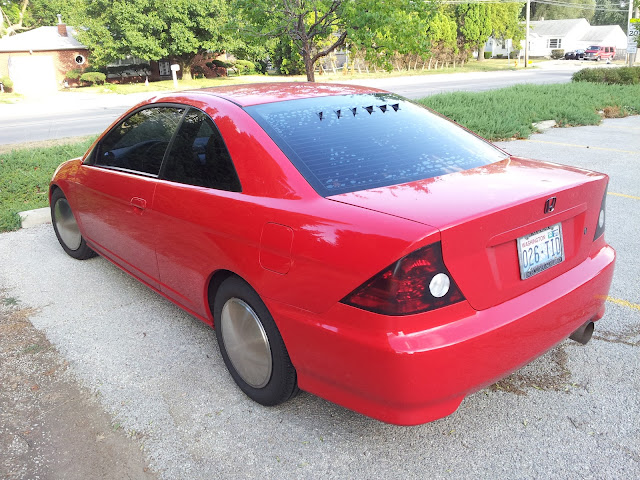Introduction: Part 2
There is a list of “65+ Efficiency Mods” on the Ecomodder website, a sticky at the top of one of the subforums. Some of the suggestions are engine- or drivetrain-related, but a fair number are aerodynamic. These range from removing roof racks to fitting solid wheel covers to building the full “boat-tail” that Ecomodders are sort of known for now, mostly through the efforts of one forum member who originated the Aerodynamic Streamlining Template (I’ll call it the “Template” from here on) as the cure-all for every aerodynamic problem.
I decided
to implement some of the most popular modifications on my 2005 Civic, in
addition to some of my own such as removing the power steering system. I took
off the exterior mirrors and bolted small convex mirrors to the sail panels
inside. I blocked off most of the cooling air intake in the front grill, first
with sheet metal and then with spray foam, shaped and fiberglassed to give a
smoothly rounded front with a small inlet duct sized just large enough so the
car wouldn’t overheat on a hot summer day. I bought Moon disk wheel covers to
go over the steel wheels. I lowered it a couple of inches on the coilovers I
had already installed on the car for autocross. I fitted corrugated plastic
panels underneath to smooth the underside.
 |
| Still my favorite car. |
What were the results? Over the next two years that I meticulously tracked every tank and mile driven, the Civic averaged 49.8 MPG—significantly higher than its EPA rating of 32 MPG.
 |
| For a 2005 EX (which has shorter gearing than other Civic trims), this is pretty good. |
But how much of that was attributable to the body modifications I had made? Well, I honestly don’t know. I had adopted the attitude I saw modeled at Ecomodder: “I think this should work, therefore it will.” Too bad the real world doesn’t function that way. It is quite possible that some of my modifications increased drag, but again I had know way of knowing because I never tested any of them. Given the fuel economy I was able to achieve, most or all of the changes to the car probably reduced aerodynamic drag, but “probably” isn’t nearly good enough for making claims or ascertaining whether the things I had built were doing what I hoped they were.
In my quest for economy, I had also wired in an engine kill switch that interrupted the fuel injectors’ common ground so that I could coast with the engine off, bump starting the car with the clutch when needed (I got so good at it that I could start it in reverse, ever so slowly rolling down the slight incline of my driveway). I also slowed down—way down. I avoided interstates unless absolutely necessary to get somewhere, favoring state highways and county routes with their lower speeds. Since aerodynamic forces vary proportionally to the square of speed, this made a huge difference—perhaps more than the modifications I had completed. But again, I can’t say for sure because I never tested anything.
I found myself inadvertently living up to what I saw modeled online: aerodynamic development by guess. In retrospect this was hugely problematic, but I had no inkling at the time. I was not an engineer by training or education (aside from several years working as a pipe organ builder); I had earned more than one college degree, but in the humanities. I had picked up a smattering of vocabulary at Ecomodder, words and phrases such as “boundary layer,” “stagnation point,” “pressure gradient,” and “streamline.” But I didn’t understand any of it, not really.
I thought I did, of course. There were plenty of threads laying out the basic aerodynamic theory behind tools like the Template, and I had read a few papers on aerodynamic development. I even went as far as taping yarn tufts to the back window, observing flow detachment at the base of the glass, and fitting vortex generators upstream to fix it—which worked!
 |
| Behold: the one lonely modification--out of everything I did to this car--tested and confirmed to work. |
But my process of modification was
largely one of building—sometimes with a huge investment of time and
materials—and hoping. That isn’t a sound basis for directing a car modification
scheme with a desired outcome, but as they say: ignorance is bliss.



Comments
Post a Comment